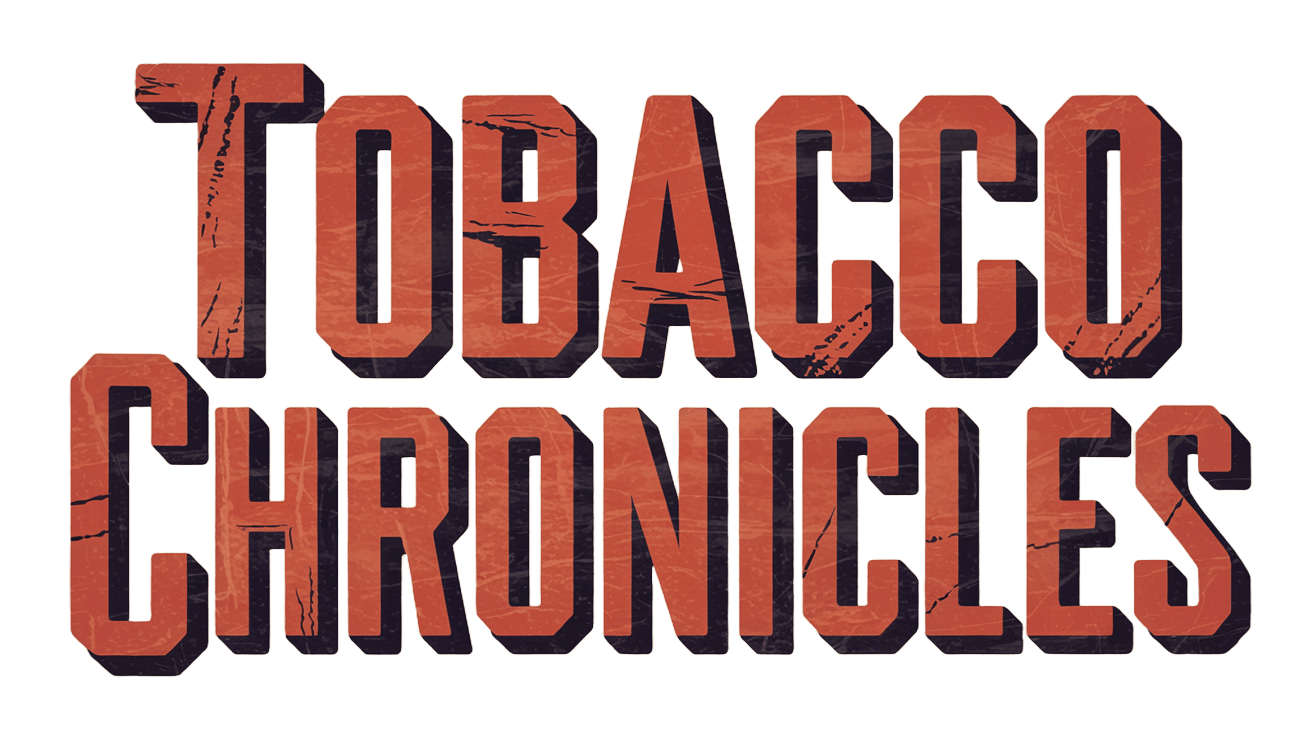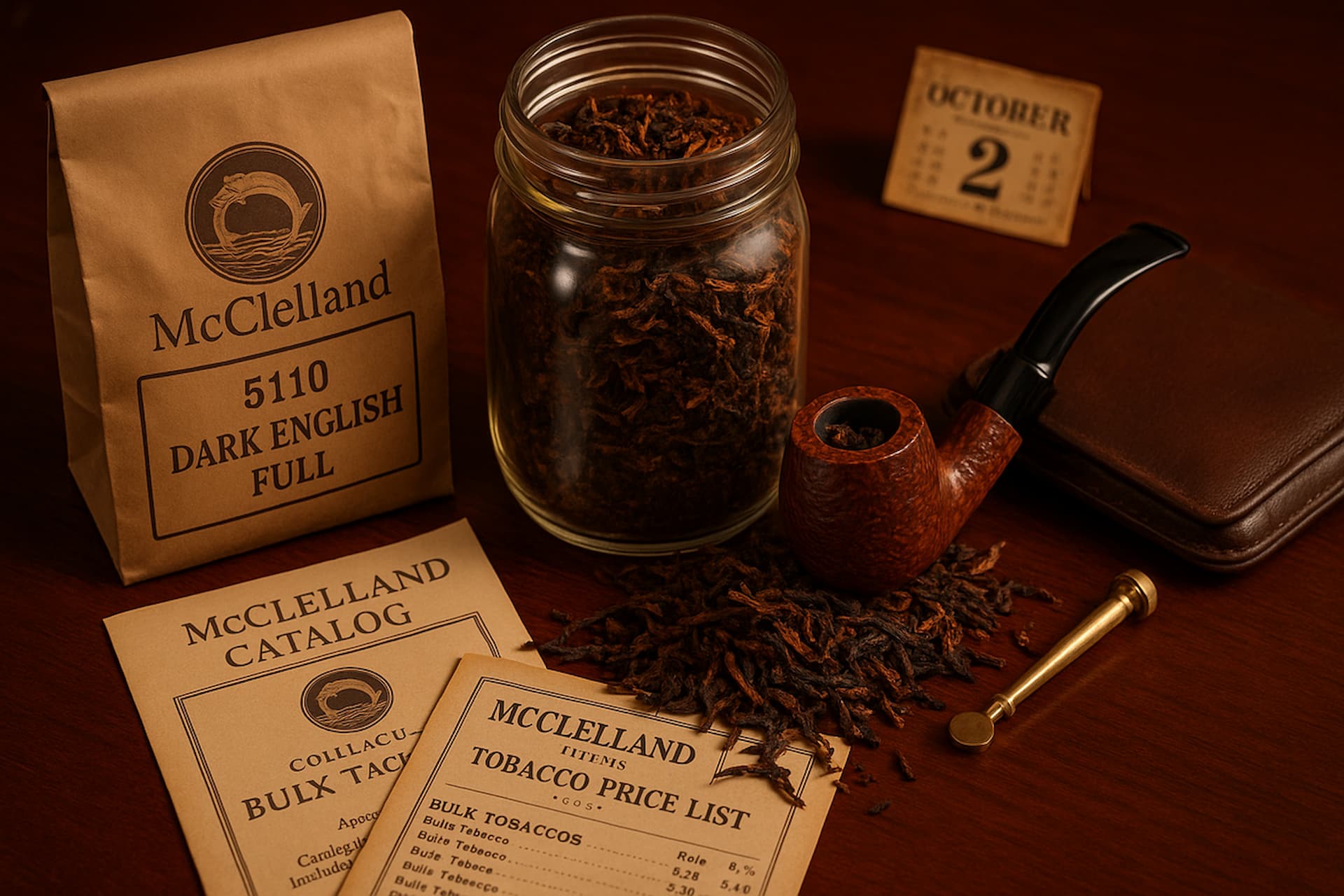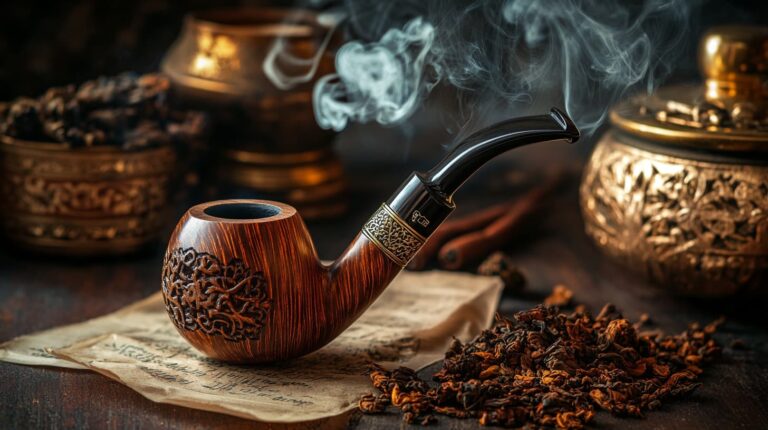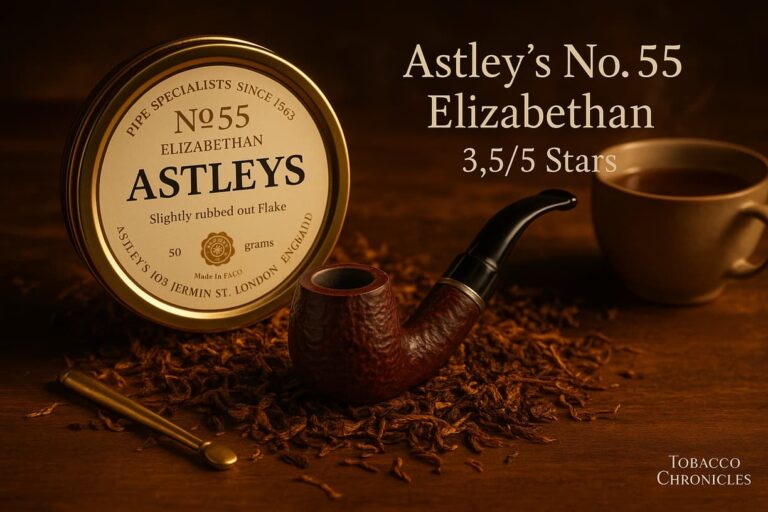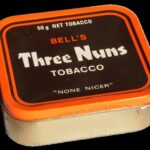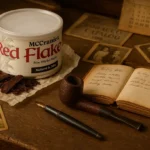“While McClelland built their reputation on Virginia tobacco mastery, their English blends represented something equally remarkable—proof that American blenders could not only match but surpass the traditional English houses at their own game. The 5110 Dark English Full stands as the crown jewel of this achievement, a blend so perfectly conceived and executed that twelve years of aging has only revealed its true genius.”
The Unexpected Masterpiece
The tin before me bears the familiar McClelland brown label, but this isn’t one of their celebrated Virginia offerings. This is McClelland 5110 Dark English Full, a 2012 vintage that has spent over a decade transforming in my cellar, developing into what I can only describe as the finest English blend ever produced on American soil. While the tobacco world mourned McClelland’s closure in 2018 primarily for their legendary Virginia blends, those of us who discovered their English mixtures knew that an equally tragic loss had occurred—the disappearance of tobacco that proved American blenders could master any style they set their minds to.
When I acquired this particular tin in 2012, McClelland was still operating from their Kansas facility, still sourcing the finest leaf available, still aging their tobacco with the patience and dedication that had made them legendary. The 5110 was described in their catalog as their “fullest mixture,” rich with Latakia, spiced with the finest Oriental leaf, and mellowed with stoved Virginia. What the catalog couldn’t convey was how these components would marry over time, how twelve years of careful aging would transform good tobacco into something approaching perfection.
The irony of McClelland’s English blends is that they were overshadowed by the company’s Virginia mastery. Pipe smokers knew to seek out McClelland for their Red Cake, their Christmas Cheer, their incomparable Virginia flakes. The English blends were almost an afterthought, a side project that demonstrated the company’s versatility but never received the attention they deserved. This oversight represents one of the great tragedies of modern pipe tobacco—some of the finest English blends ever created were hiding in plain sight, dismissed by smokers who assumed that only British houses could produce authentic English mixtures.
The 5110 challenges every assumption about what American tobacco can achieve. This isn’t an American interpretation of English blending—this is English blending perfected by American hands, using American patience and American attention to detail to create something that surpasses its inspirations. The blend demonstrates that greatness in tobacco isn’t about geography or tradition—it’s about understanding tobacco, respecting the leaf, and having the skill to combine components in ways that create harmony rather than mere mixture.
The Architecture of Excellence
Opening this twelve-year-old tin reveals tobacco that has undergone a remarkable transformation. The ribbon cut maintains its structure beautifully, with individual strands that separate easily while retaining the perfect moisture content that allows for effortless packing. The color palette tells the story of the blend’s composition: the dark, almost black strands of Latakia provide the visual foundation, while lighter brown Virginia ribbons weave throughout, punctuated by the golden highlights of Oriental leaf that catch the light like scattered coins.
The tin note is immediately arresting—rich, complex, and utterly distinctive. The Latakia announces itself with its characteristic smokiness, but this isn’t the harsh, aggressive smoke of lesser blends. Instead, it’s the deep, woody smoke of tobacco that has been properly cured and aged, smoke that speaks of campfires and leather rather than ash and char. Beneath this smoky foundation, the Oriental tobacco contributes a spicy sweetness that adds complexity without overwhelming the blend’s essential character. The Virginia component provides a subtle honey-like sweetness that rounds out the sharper edges and creates the harmonious integration that distinguishes great tobacco from merely good tobacco.
What strikes me most about this aged 5110 is how completely the components have married. In younger English blends, you can often detect the individual contributions of each tobacco type—the Latakia here, the Oriental there, the Virginia providing background sweetness. In this twelve-year specimen, such distinctions have largely disappeared, replaced by a unified character that incorporates all these elements into something greater than the sum of its parts. This is what proper aging can accomplish when applied to properly blended tobacco—not just the mellowing of harsh edges, but the creation of entirely new flavor compounds through the slow chemical processes that occur over years of careful storage.
The moisture content is perfect, neither too dry nor too moist, allowing the tobacco to pack easily in the bowl while maintaining the structure necessary for even burning. This balance is crucial for English blends, which can become harsh if too dry or difficult to keep lit if too moist. The 5110 achieves that sweet spot where the tobacco feels alive in your hands, responsive to pressure but not fragile, ready to deliver its full character without requiring special handling or preparation.
The Smoking Experience: Complexity Revealed
I’ve chosen to smoke this remarkable tobacco in a Castello Collection bent apple, a pipe whose generous bowl and excellent engineering provide the perfect platform for experiencing the 5110’s full character. The initial charring light reveals the blend’s complexity immediately—the Latakia provides the dominant first impression, but it’s a refined, sophisticated smokiness that speaks of quality leaf and proper processing. This isn’t the overwhelming Latakia bomb that characterizes some English blends; instead, it’s Latakia used as it should be, as a seasoning that enhances rather than dominates.
As the tobacco settles into its rhythm, the true genius of the 5110 becomes apparent. The Oriental tobacco begins to assert itself, contributing a spicy complexity that adds layers of flavor without creating confusion. These aren’t the harsh, aggressive spices of poorly handled Oriental leaf, but the refined, almost incense-like qualities that distinguish the finest Turkish and Macedonian tobaccos. The spice is warm and inviting, creating a sense of exotic sophistication that elevates the entire smoking experience.
The Virginia component in this aged specimen has developed into something truly special. Rather than providing simple sweetness, it contributes a complex honey-and-hay character that serves as both foundation and bridge, connecting the smoky Latakia with the spicy Orientals while adding its own distinctive voice to the conversation. This is Virginia tobacco at its finest—not the bright, sometimes sharp character of younger leaf, but the mellow, complex sweetness that develops through proper aging and careful blending.
What makes this smoking experience truly exceptional is the way these flavors evolve throughout the bowl. The first third emphasizes the Latakia character, establishing the blend’s smoky foundation while allowing hints of the other components to emerge. The middle third achieves perfect balance, with all components contributing equally to create a harmony that is both complex and satisfying. The final third reveals the Virginia character most fully, as the natural sugars in the leaf caramelize from the heat, creating a sweet, almost dessert-like finish that provides the perfect conclusion to the smoking experience.
The smoke itself is remarkably cool and smooth, never harsh or biting despite the blend’s full-bodied character. This coolness is partly a function of the tobacco’s age—twelve years of mellowing has eliminated any rough edges that might have existed in the fresh blend—but it also speaks to the quality of the original blending. The components have been selected and proportioned to work together, creating a smoking experience that is both satisfying and comfortable, complex enough to hold your attention but smooth enough to enjoy without effort.
The McClelland Legacy in English Blending
To understand what makes the 5110 special, one must understand McClelland’s approach to tobacco blending. While the company was founded in 1977 and built its reputation on Virginia tobacco, the McNiel family brought a distinctly American perspective to traditional tobacco styles. They weren’t bound by centuries of tradition or constrained by the assumption that certain styles could only be produced in certain places. Instead, they approached each blend as a problem to be solved, a challenge to create the best possible tobacco regardless of conventional wisdom.
This American approach is evident throughout the 5110. The blend incorporates the best elements of traditional English mixtures—the smoky depth of Latakia, the spicy complexity of Oriental tobacco, the sweet foundation of Virginia leaf—but combines them with a precision and attention to balance that reflects American engineering sensibilities. The result is tobacco that honors the English tradition while surpassing it, creating something that is both familiar and revolutionary.
The quality of the leaf used in the 5110 reflects McClelland’s commitment to sourcing the finest tobacco available. The Latakia has the deep, complex character that comes from proper curing over aromatic woods, while the Oriental tobacco displays the refined spice that distinguishes premium leaf from commercial grades. The Virginia component shows the natural sweetness and complexity that develops when quality leaf is properly aged before blending. This attention to sourcing created the foundation for the blend’s excellence, providing the raw materials necessary for creating truly exceptional tobacco.
Perhaps most importantly, the 5110 demonstrates McClelland’s understanding of time as an ingredient. This isn’t tobacco that was blended and immediately packaged; it’s tobacco that was aged after blending to allow the components to marry and develop. This aging process, combined with the additional twelve years in my cellar, has created tobacco that displays a level of integration and complexity that simply cannot be achieved through blending alone. It’s a testament to the patience and vision that characterized McClelland’s approach to tobacco production.
The tragedy of McClelland’s closure extends beyond the loss of their Virginia blends to encompass the disappearance of their English mixtures. The 5110 represents a level of quality and sophistication that may never be replicated, not because the techniques are lost, but because the combination of vision, patience, and commitment to quality that characterized McClelland has become increasingly rare in the modern tobacco industry. This blend stands as a monument to what American tobacco blending could achieve when guided by uncompromising standards and unlimited ambition.
The Alchemy of Age
Comparing this twelve-year-old 5110 to my memories of the fresh blend reveals the transformative power of proper aging. When first released, the 5110 was excellent tobacco—well-balanced, flavorful, and satisfying. But it was also somewhat aggressive, with individual components that asserted themselves boldly and a character that demanded attention. The aged version represents a complete evolution, with the aggressive edges smoothed away and the individual components integrated into a harmonious whole that is both more complex and more approachable than the original.
The Latakia in this aged specimen has developed a depth and sophistication that wasn’t present in the fresh blend. Rather than the sometimes harsh smokiness of young Latakia, this tobacco displays the mellow, woody character that develops through extended aging. The smoke is still present and prominent, but it’s refined smoke, smoke that enhances rather than overwhelms, smoke that adds complexity without creating harshness. This transformation demonstrates why serious pipe smokers invest in cellaring tobacco—the difference between fresh and properly aged tobacco can be the difference between good and transcendent.
The Oriental tobacco has undergone an equally remarkable transformation. The sometimes sharp spices of fresh Oriental leaf have mellowed into a warm, complex character that adds depth without creating bite. The spice is still present, but it’s integrated spice, spice that works in harmony with the other components rather than competing for attention. This mellowing allows the subtle floral and incense-like qualities of premium Oriental tobacco to emerge, adding layers of complexity that weren’t apparent in the younger blend.
Perhaps most remarkably, the Virginia component has developed into something approaching perfection. The natural sugars in the leaf have undergone slow chemical changes that have created new flavor compounds, resulting in a sweetness that is both more complex and more subtle than what was present in the fresh tobacco. This isn’t the simple honey sweetness of young Virginia, but a complex, almost wine-like character that provides the perfect counterpoint to the smoky Latakia and spicy Orientals.
The overall effect of this aging is to create tobacco that is both more complex and more approachable than the original. The individual components have not only mellowed but have combined to create entirely new flavors that weren’t present in the fresh blend. This is the alchemy of tobacco aging—the transformation of good tobacco into something approaching perfection through the patient application of time and proper storage conditions.
A Standard for Excellence
In the pantheon of great English blends, the McClelland 5110 Dark English Full occupies a unique position. It stands alongside legendary blends like Balkan Sobranie, Dunhill My Mixture 965, and Esoterica Penzance as tobacco that defines what English blending can achieve at its finest. But unlike these British classics, the 5110 represents something distinctly American—tobacco that honors tradition while transcending it, creating something that is both familiar and revolutionary.
What sets the 5110 apart from other English blends is its perfect balance. Many English mixtures excel in one area while sacrificing others—some emphasize Latakia to the point of overwhelming the other components, others focus on Oriental complexity while neglecting the Virginia foundation, still others achieve smoothness at the cost of character. The 5110 achieves excellence in all areas simultaneously, creating tobacco that is complex without being confusing, full-bodied without being harsh, sophisticated without being pretentious.
This balance extends to the smoking experience itself. The 5110 is tobacco that can be appreciated by both novice and expert smokers, offering enough complexity to satisfy the most demanding palate while remaining approachable enough for those new to English blends. It’s tobacco that rewards attention while not demanding it, tobacco that can serve as both a contemplative smoke and a casual pleasure. This versatility is the mark of truly great tobacco—the ability to satisfy different needs and different moods while maintaining its essential character.
The 5110 also demonstrates the importance of proper aging in tobacco appreciation. While the fresh blend was excellent, this twelve-year specimen represents a completely different level of achievement. The aging has not only improved the tobacco but has transformed it, creating flavors and characteristics that simply weren’t present in the original. This transformation serves as a reminder that tobacco is a living product that continues to evolve and improve under proper conditions, rewarding patience with experiences that cannot be purchased but must be earned through time.
For those fortunate enough to possess aged specimens of the 5110, this tobacco represents more than just a smoking experience—it’s a connection to a lost era of American tobacco blending, a reminder of what could be achieved when quality was the only consideration and time was treated as an ingredient rather than an obstacle. Each bowl is both a pleasure and a memorial, a celebration of excellence and a lament for what has been lost.
The Final Verdict
As I reach the final third of this bowl, savoring the sweet, caramelized flavors that emerge as the Virginia tobacco reaches its full expression, I’m struck by the profound sadness that accompanies this pleasure. This is tobacco that will never be made again, not because the techniques are lost or the ingredients unavailable, but because the vision and commitment that created it have become casualties of modern commerce. The 5110 represents the end of an era, the final expression of American tobacco blending at its absolute finest.
Yet there is also profound gratitude in this experience. To smoke tobacco of this quality is to understand what pipe smoking can be at its finest—not just a habit or a pleasure, but a connection to craftsmanship, tradition, and the patient application of skill over time. The 5110 reminds us why we cellar tobacco, why we seek out the finest blends, why we invest time and attention in understanding the subtle differences that separate good tobacco from great tobacco.
This twelve-year-old McClelland 5110 Dark English Full represents the pinnacle of what American tobacco blending achieved in the modern era. It stands as proof that excellence knows no geographical boundaries, that tradition can be honored while being transcended, and that patience and vision can create tobacco that approaches perfection. For those who never experienced McClelland’s English blends, this review can only hint at what was lost when the company closed. For those fortunate enough to possess aged specimens, each bowl is both a privilege and a responsibility—a chance to experience tobacco history and an obligation to remember what American blending could achieve when guided by uncompromising standards.
In a world where so much tobacco is produced for immediate consumption and maximum profit, the 5110 stands as a monument to different values—quality over quantity, patience over speed, excellence over adequacy. It reminds us that tobacco can be art as well as commerce, that blending can be craft as well as industry, and that some things are worth preserving not because they are profitable but because they are perfect.
Rating: ★★★★★ (5/5 stars)
Availability: Discontinued
Manufacturer: McClelland Tobacco Company (1977-2018)
Blend Type: English Mixture
Primary Components: Latakia, Oriental, Stoved Virginia
Strength: Medium-Full to Full
Character: Rich, smoky, complex, perfectly balanced
Aging Potential: Exceptional (this 12-year specimen demonstrates remarkable improvement)
Cut: Ribbon
Heritage: McClelland’s “fullest mixture,” representing the pinnacle of American English blending
Some tobacco transcends its origins to become something larger than the sum of its parts. The McClelland 5110 Dark English Full represents such tobacco—a blend that proved American hands could not only match but surpass the traditional English houses at their own game. This twelve-year specimen stands as a testament to what patience, skill, and uncompromising standards could achieve, a reminder of excellence that will never be replicated and can never be replaced. In every bowl lies the story of American tobacco blending at its absolute finest, a story that ended too soon but whose memory will endure as long as there are pipe smokers who understand the difference between good tobacco and greatness.
